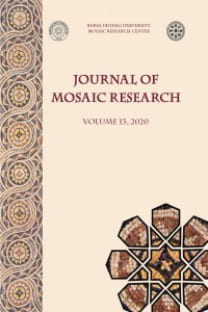The Ship Depicted on the North Colonnade of the Great Mosque at Damascus: A Nilotic Theme or the Representation of Paradise?
Şam'daki Emeviye Camii Kuzey Sütun Dizisi Üzerinde Yer Alan Gemi Tasviri: Nil Nehrine Ait Bir Konu ya da Cennet Tasviri?
___
- Asad 1980 M. Asad, The Messages of the Qur'?n; Dar al-Andalus, Gibraltar.
- Bell 1908 H. I. Bell, "The Aphrodito Papyri", JHS 28: 97-120.
- Bell 1912 H. I. Bell, "The Translations of the Greek Aphrodito Papyri in the British Museum", Der Islam 3, 1: 369-373.
- Brisch 1988 K. Brisch, "Observations on the Iconography of the Mosaics in the Great Mosque at Damascus", P. Soucet(ed.), Content and Context of Visual Arts in the Islamic World, 13-23.
- Cooper 1987 J. C. Cooper, An Illustrated Encyclopaedia of Traditional Symbols, London, Thames and Hudson.
- Creswell - van-Berchem 1932 K. A. C. Creswell - Marguerite van-Berchem, Early Muslim Architecture: Umayyads, Early Abbasids and T?l?nides, Part II: The Mosaics of the Dome of the Rock and the Great Mosque at Damascus, Vol. I, Oxford, Claredon Press.
- Creswell - van-Berchem 1969 K. A. C. Creswell - Marguerite Guatier van-Berchem: Early Muslim Architecture: Umayyads A.D. 622-750,Part II: The Mosaics of the Dome of the Rock in Jerusalem and of the Great Mosque in Damascus, Vol. I, Second Edition, Oxford, Claredon Press.
- Degeorge 2010 G. Degeorge, La Grande Mosquée des Omeyyades Damas, Arles, Impromerie Nationale Éditions.
- Friedman 2005 Z. Friedman, "Boats depicted in the 8th century CE Nilotic frame mosaic in the Church of St. Stephen, Umm al-Rasas, Jordan", LA 55: 395-417 pls. 51-56.
- Friedman 2007 Z. Friedman, "The Nile Mosaic of Palestrian: an Illustration of Shipbuilding Traditions", Archaelogia Maritima Mediterranea 3: 115-145.
- Hamerneh 1999 B. Hamerneh, "The River Nile and Egypt in the Mosaics of the Middle East", M. Piccirillo - E. Alliata (eds.), The Madaba Map Centenary 1897-1997: Travelling Through the Byzantine Umayyad Period, Jerusalem,StBiFranc, 185-190.
- Koran M. A. Maul?n?, The Holy Quran: Arabic Text, Translated and Commentaries, Lahore.
- Landstrom 1970 B. Landstrom, Ships of the Pharaohs: 4000 years of Egyptian shipbuilding, New York, Doubleday and Company Inc.
- Lohuizen-Mulder 1995 M. E. Van Lohuizen-Mulder, "The Mosaics in the Great Mosque at Damascus: a Vision of Beauty", BABesch 70: 193-213.
- Maguire 1987 H. Maguire, Earth and Ocean: The Terrestrial World in Early Byzantine Art, University Park and London, The Pennsylvania State University Press.
- McKenzie 2010 J. McKenzie, The Architecture of Alexandria and Egypt c.300 BC to AD 700, New Haven and London, Yale University press.
- Piccirillo 1988 M. Piccirillo, "The Mosaics at Umm er-Rasas, Jordan", BiblArch 51, 4: 208-213, 227-231.
- Piccirillo 1993 M. Piccirillo, The Mosaics of Jordan, ACOR, Amman, Jordan.
- Piccirillo - Attiyat 1986 M. Piccirillo - T. Attiyat, "The Complex of the Umm er-Rasas - Kastron Mefaa: The First Campaign, August 1986", ADAJ 30: 341-351, pls. LXX-LXXVII.
- Piccirillo - Alliata 1994 M. Piccirillo, E. Alliata, Umm al-Rasas- Mayfa'ah I: Gli scavi del complesso di Santo Stefano, Jerusalem, StBiFranc.
- ISSN: 1309-047X
- Yayın Aralığı: 1
- Başlangıç: 2008
- Yayıncı: Ululdağ Üniversitesi, Mozaik Araştırlmaları Merkezi
Le Projet de Corpus des Mosaïques d'Albanie
Marie-Patricia RAYNAUD, Agron ISLAMI
Before the Corpus: Byzantine Mosaics in Istanbul in Nineteenth-Century French Guide-Books
The Orpheus Mosaic of Prusias ad Hypium
Written and Visual Culture About the Mosaic of Castulo: The Influence of Lucian's Works
The Basilica Mosaic on Asar Island at Myndos
Looking at Two Patterns Inspired in Coffered Ceilings: Some Examples in the Portuguese Roman Mosaics
